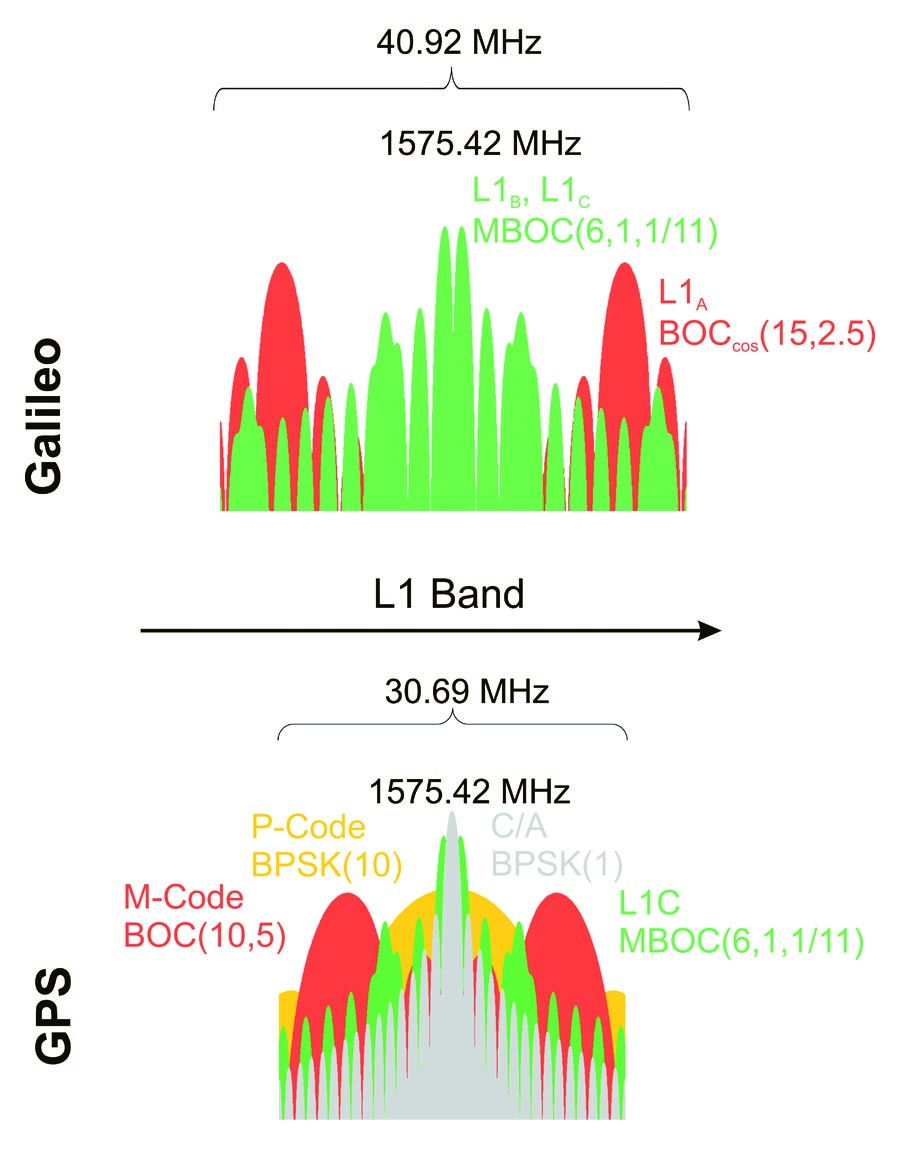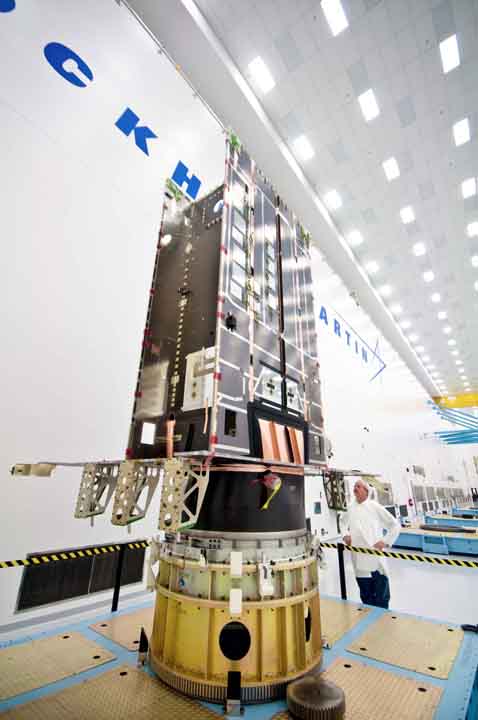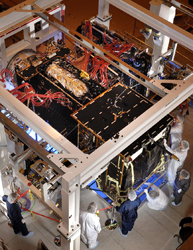Sidebar: Time for Precise Positioning
Return to main article: "Truth on the Range"
By Inside GNSSReturn to main article: "Truth on the Range"
By Inside GNSS MBOC signal at top, BOC (1,1) at bottom
MBOC signal at top, BOC (1,1) at bottom(Updated May 21) U.S. warfighters could be affected and European navigation users could end up paying more if the British are able to enforce a patent on technology at the heart of the new GPS and Galileo civil signals.
By Inside GNSS
The launch of the first GPS III satellite has slipped to 2015 and completion of the ground control system is now delayed by up to two years, according to the chief of the Air Force’s space operations
“We’ll be ready to launch the first GPS III in 2015, but it now appears the next generation GPS Operational Control System, or OCX, won’t be ready for about a year or two after that,” General William L. Shelton, commander of Air Force Space Command told attendees at the 28th Annual National Space Symposium.
By Inside GNSS Variations on the common GPS/Galileo MBOC signal
Variations on the common GPS/Galileo MBOC signalThe U.S. government is so unhappy about a British patent claim on the new civil GPS signal that, if things cannot be worked out, officals might consider abandoning the countries’ interoperable signal structure, sources told Inside GNSS.
By Inside GNSS The core structure of the GPS III Non-Flight Satellite Testbed (GNST) stands vertical in Lockheed Martin’s GPS III Processing Facility. LM photo.
The core structure of the GPS III Non-Flight Satellite Testbed (GNST) stands vertical in Lockheed Martin’s GPS III Processing Facility. LM photo.An emphasis on quality assurance in system engineering and components in the first GPS III satellite now under development has driven projected costs up in the program above the budgeted amount, leading the U.S. Air Force to deny a $70 million incentive fee to prime contractor Lockheed Martin.
By Inside GNSS
Raytheon Company and Lockheed Martin have successfully completed the first significant integration milestone between Raytheon’s Next Generation GPS Operational Control System (OCX) and Lockheed Martin’s GPS III satellite development.
By Inside GNSS Dr. Anthony Pratt, Orbstar International Ltd.
Dr. Anthony Pratt, Orbstar International Ltd.In the beginning, there was just the Global Positioning System. But it provided an astounding start to the world of GNSS.
Since the United States declared full operational capability (FOC) for GPS in 1995, two major things have occurred:
By Inside GNSS Sergey Revnivykh, GLONASS program, Roscosmos
Sergey Revnivykh, GLONASS program, RoscosmosGLONASS completed its long trek back to full operational capability with 24 operational satellites in the constellation last December, but Russia intends to keep pushing ahead with its GNSS, said Roscosmos official Sergey Revnivykh at the Munich Satellite Navigation Summit in March.
GLONASS now has a 347 billion ruble (US$11.81 billion) budget approved through 2020, by which time the system is scheduled to have 24 satellites transmitting both the new CDMA and legacy FDMA signals.
By Inside GNSS New GPS III Test Chamber (Lockheed Martin photo)
New GPS III Test Chamber (Lockheed Martin photo)The United States GPS program is without doubt the elder statesman of GNSS, but it has had some close calls recently.
At the 2012 Munich Satellite Navigation Summit in March, a high-level Department of Transportation offical and the head of the Air Force GPS Directorate hailed continuing progress on the Global Positioning System’s third-generation satellite development and next-generation control segment (OCX), while apparently escaping — relatively unscathed — the dual perils of Congressional budget cuts and LightSquared interference.
By Inside GNSS Galileo by Irina of Romania
Galileo by Irina of Romania[Updated March 27] We see lots of graphs, schemata, renderings and photographic images of the GNSS satellites and constellations. Perhaps it’s time to rest the eyes with imaginative images of space and satellites through the eyes of children.
Over a number of years, up to 30 of Europe’s Galileo navigation satellites are expected to reach orbit and each of them will be named after a child from one of the 27 European Union countries.
By Inside GNSS UrsaNav LF transmitter site for timing synchronization trials
UrsaNav LF transmitter site for timing synchronization trialsVirginia-based engineering firm UrsaNav Inc. has begun transmitting a variety of low frequency (LF) test signals, including enhanced Loran (eLORAN), as part of a cooperative research and development agreement (CRADA) with the U.S. Coast Guard (USCG).
The test program include a comprehensive palette of signals that are being evaluated for their ability to provide a robust, wide-area, wireless precise timing alternative that can operate cooperatively with GNSS technology or autonomously during GNSS unavailability.
By Inside GNSS SBIRS GEO-2 satellite in Baseline Integrated System Test (BIST-1). Lockheed Martin photo.
SBIRS GEO-2 satellite in Baseline Integrated System Test (BIST-1). Lockheed Martin photo.The Air Force is poised to forego putting nuclear detonation detection sensors on the Space-Based Infrared System (SBIRS) satellites, a decision that could complicate efforts to maintain the GPS system by hampering plans to launch multiple, lighter GPS satellites on a single rocket.
By Inside GNSS